 Forget 5G. 6G will be 100 times faster with 50 times the data throughput and will use frequencies in the terabit-per-second range. This will rival fiber optic capability. By comparison, 5G currently sends data at only gigabit speeds. 6G will have its biggest application in creating digital twins and digitizing the physical world. Technocracy News & Trends Editor Patrick Wood
Forget 5G. 6G will be 100 times faster with 50 times the data throughput and will use frequencies in the terabit-per-second range. This will rival fiber optic capability. By comparison, 5G currently sends data at only gigabit speeds. 6G will have its biggest application in creating digital twins and digitizing the physical world. Technocracy News & Trends Editor Patrick Wood
By: Dr. Yu-Han Chang via IDTechEX
6G, compared to its predecessor, is expected to offer significantly better communication capabilities, such as Tbps-level peak data rates, microsecond-level latency, and 99.99999% network dependability.
Although 6G promises a lot, it is unlikely that 6G will be in daily life soon, despite the fact that several important companies and nations have already begun 6G research, as shown in the figure below, the telecom industry needs to address several issues before seeing the success of 6G. The difficulties are not only in THz technology but also in identifying applications that will fuel 6G adoption. IDTechEx has been researching 5G and 6G for years. This article will discuss some of the hardware-related hurdles to 6G connectivity, as well as potential applications that could drive 6G.
Key differences of 6G. Source: IDTechEx – “6G Market 2023-2043: Technology, Trends, Forecasts, Players”
Challenges in THz Technology
6G will use a spectrum above 100 GHz and will ultimately reach THz. The advantages of employing such a high frequency are obvious: huge bandwidth may be used, allowing for Tbps peak data flow with microsecond-level latency. However, there are several limitations to employing such a high-frequency spectrum.
One of the most significant challenges ahead is that the THz signal attenuates considerably in the air, restricting the transmission range and making it easily blocked by obstructions. Because the laws of physics cannot be ignored, the most crucial element for creating a device for high-frequency communication is to provide enough energy to achieve a reasonable transmission range, even as part of an antenna array.
Activist Post is Google-Free
Support us for just $1 per month at Patreon or SubscribeStar
Choosing the right semiconductors to increase link range is the most critical. Below is an overview of semiconductor technology choices operating above the 100 GHz spectrum. CMOS can cover devices operating below 150 GHz, especially for short-range communication requirement devices (For longer range, using other semiconductors such as SiGe or III-V for power amplifiers may still be required). When it comes to frequencies above 200 GHz, however, a combination of CMOS for logic and III-V transistors for low-noise amplifiers and power amplifiers will be the way to go. SiGe BiCMOS technology currently provides the best compromise in terms of performance, low cost, and simplicity of integration for frequencies ranging from 200 GHz to 500 GHz. InP could be the ultimate THz technology and may be suitable in applications where cost is not the primary concern.
Overview of semiconductor technology choice for THz RF. Source: IDTechEx – “6G Market 2023-2043: Technology, Trends, Forecasts, Players”
Other active research and development areas aside from semiconductor technologies include the need to find ultra-low-loss materials with a low dielectric constant and tan loss to avoid significant transmission loss, develop a novel packaging methodology that tightly integrates the RF components with antennas, and manage power and thermal issues as devices become more compact and complex. IDTechEx’s 6G market research report, “6G Market 2023-2043: Technology, Trends, Forecasts, Players,” discusses these challenges in detail.
Applications That Could Fuel 6G Adoption
It is essential to identify key business use cases to stimulate the uptake of new technologies. Despite carriers’ touting the superior performance that 5G mmWave provides, the mmWave market has yet to take off despite years of 5G’s commercialization. The vast majority of 5G build-outs continue to use 5G sub-6 GHz. The reasons? The one reason that most people mention, according to IDTechEx’s primary interviews, is the absence of applications that can be only enabled by mmWave and no other technologies. The same question about 6G will be asked: why is it needed?
From a consumer’s perspective, having a Tbps data link and microsecond level latency but paying a higher subscription fee will probably not be attractive if the applications on their mobile devices are pretty much the same as what they have right now. We’ve heard a lot about hypes going on metaverse enabling by 5G and 6G, yet, the real-life use cases that can drive widespread adoption are still lacking. However, it should not be forgotten that 6G will have its unique capability in sensing, imaging, precise positioning, and so on. These characteristics will open other business use cases and enable 6G to be used in areas beyond mobile communication, which can further drive advanced digitalization and automation of various industries. For example, using 6G networks to achieve accurate perception and centimeter-level positioning of mobile robots, demonstrating the ability to remotely control mobile robots to pick up and carry various objects. At the same time, this transmission link also carries the high-speed wireless transmission of real-time high-definition video between the mobile robot and the controller, enabling synaesthesia integration. Furthermore, as the spectrum expands beyond 275 GHz, interesting use cases worth highlighting include the use of THz connections as wireless links to replace fiber for data centers, enabling reconfigurable routes and allowing the reduction of the size of server/router racks, and of course, significant cost reduction; and creating one or multiple point-to-point high-speed communication links within a device, enabling faster routing.
To summarize, the strong business cases IDTechEx sees for 6G are presently centered on business-to-business use cases. However, this is not to suggest that 6G will not be essential in consumer communication markets; rather, a compelling use case must be demonstrated in order to promote widespread adoption in consumer markets.
Sourced from Technocracy News & Trends
Become a Patron!
Or support us at SubscribeStar
Donate cryptocurrency HERE
Subscribe to Activist Post for truth, peace, and freedom news. Follow us on SoMee, Telegram, HIVE, Flote, Minds, MeWe, Twitter, Gab, What Really Happened and GETTR.
Provide, Protect and Profit from what’s coming! Get a free issue of Counter Markets today.



Be the first to comment on "6G: Critical Information You Need To Know"